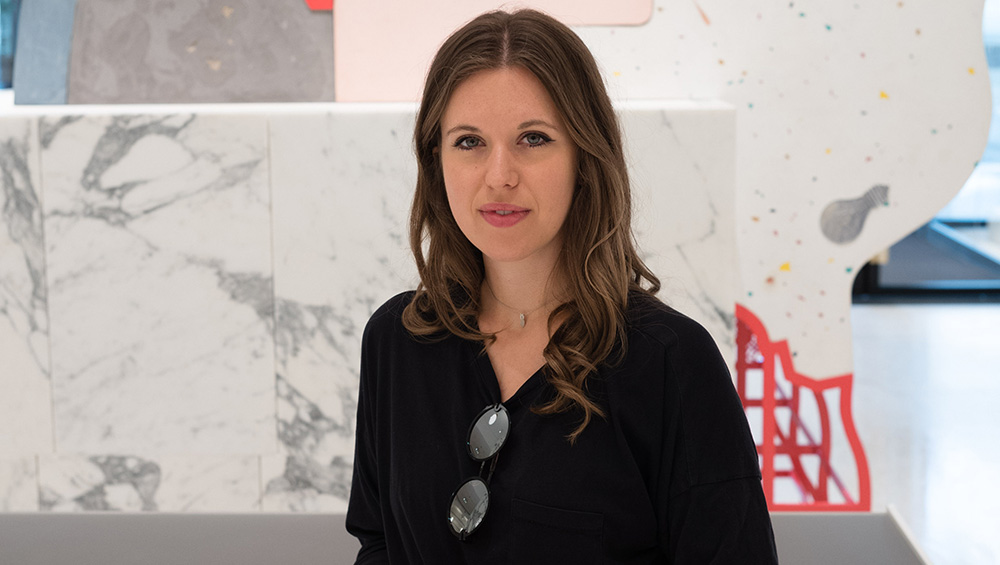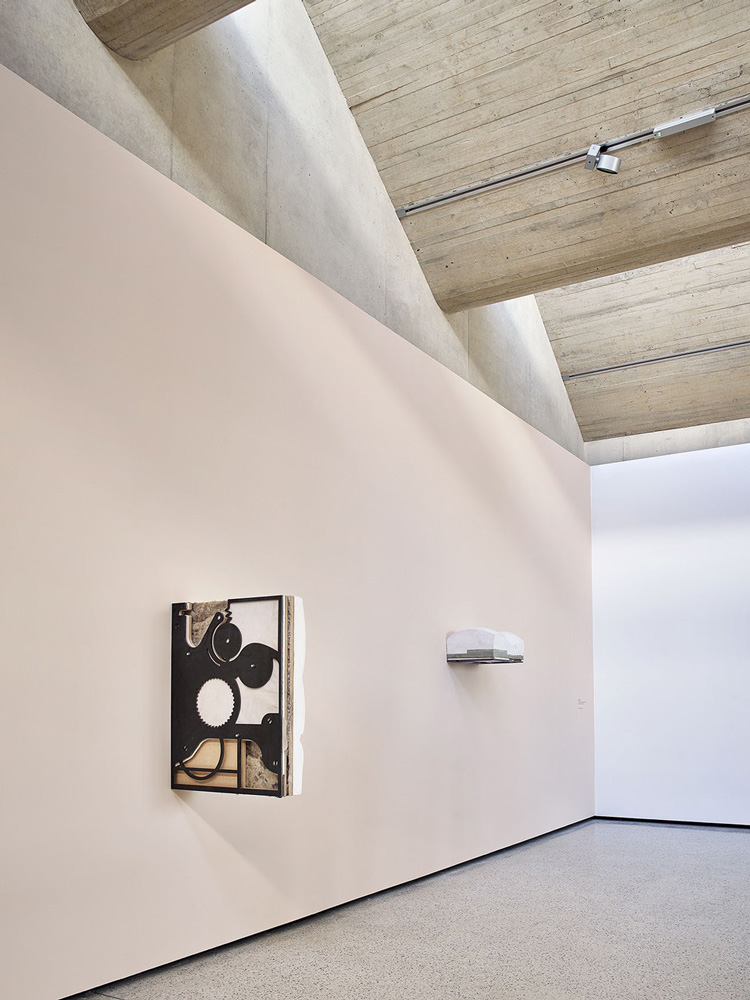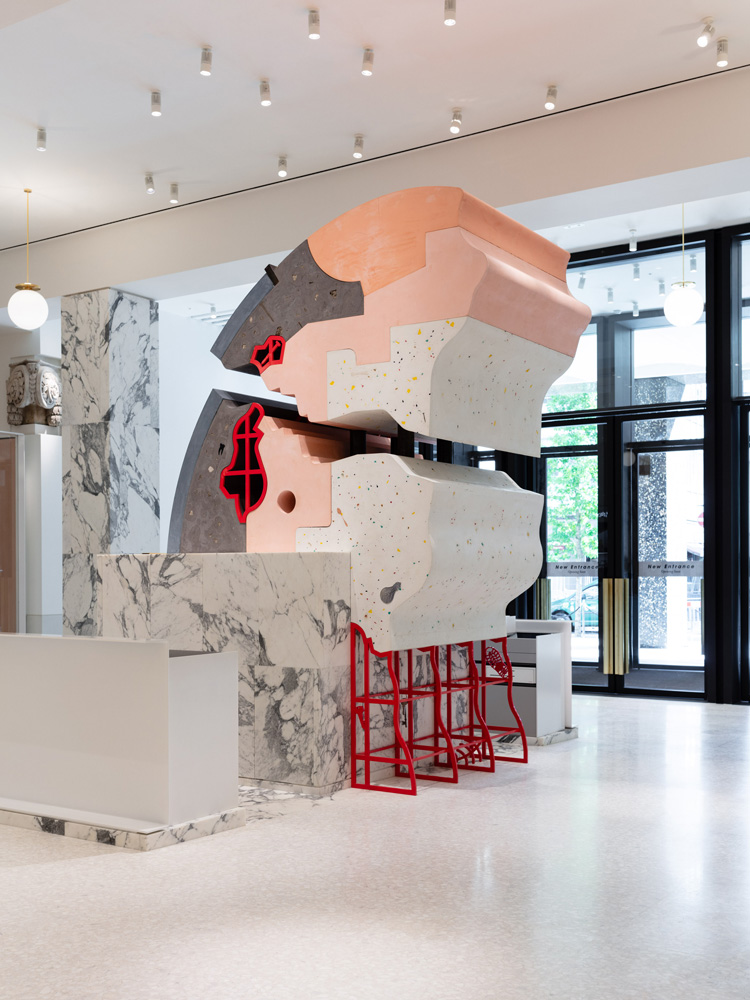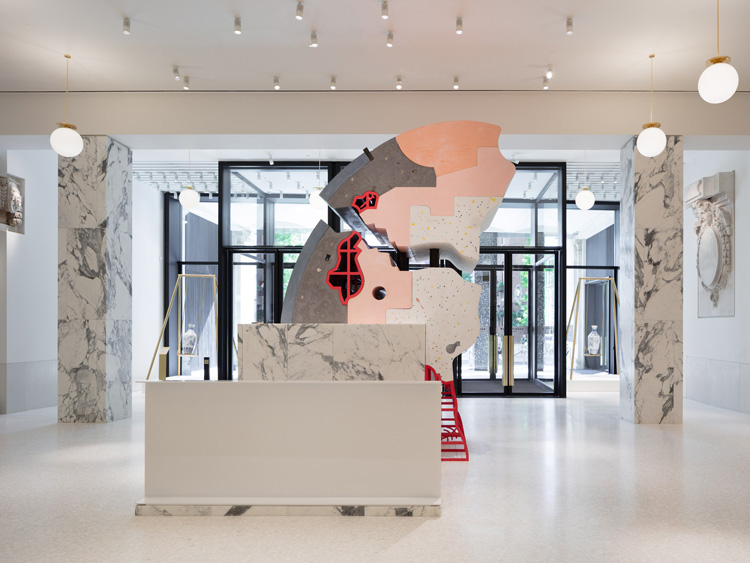
by DAVID TRIGG
Since graduating from the Royal College of Art in 2016, Holly Hendry (b1990, London) has enjoyed a string of high-profile exhibitions, including a major solo show at the Baltic Centre for Contemporary Art, Gateshead, and a new commission for Liverpool Biennial 2018. Also in 2018, she became the first artist to create new work for Selfridges’ Art Block, a permanent venue for sculpture within the retailer’s flagship London store. Her large, site-responsive sculptures and installations are concerned with that which lies beneath the surface – from hidden underground spaces below our feet to the interior workings of our bodies.
Casting is central to her process, which she uses to combine a dizzying array of materials, including steel, Jesmonite, silicone, ash, charcoal, lipstick, soap, foam, marble, aluminium and grit. Her new exhibition at Yorkshire Sculpture Park, The Dump Is Full of Images, explores themes of decay and the body and the use and reuse of materials. Central to the exhibition, and filling the park’s new Weston Gallery, is Slacker, Hendry’s first kinetic sculpture. A synthetic skin-like band incorporating cartoon-like images of body parts, bones and organs is pulled around a large steel structure on rollers. Taking the form of a reclining figure, Slacker is embedded with rubbish from the artist’s studio, inviting audiences to consider the value that gets placed on the objects that fill our lives.

Holly Hendry, Slacker, 2019 (detail). Courtesy the artist and Yorkshire Sculpture Park. Photo © Mark Reeves.
David Trigg: What was the starting point for Slacker?
Holly Hendry: I’d been reading Miles Orvell’s book The Real Thing, which is about replication and authenticity. In the epilogue, he talks about junk as a perceived system of disorder and the idea of mass-produced objects becoming something individual again as they’re used, reused and then thrown away. At the same time, I was thinking about ideas of deadness, flatness and fullness, and also the slapstick idea of bodily collisions with machines, or the fear of that.
DT: Slacker references a reclining figure, but has the appearance of a printing press or some other kind of industrial machine. How did you arrive at its form?
HH: It came from being at Yorkshire Sculpture Park and looking out at the landscape while the new Weston Gallery was half-built. I was thinking about the lines of the building and its positioning in the landscape. I was also thinking about the Henry Moore sculptures there, the recumbent figure and the act of lying down, whether through sleeping, exhaustion or death. For me, this all links to activity and passivity: the movement that happens during stillness, such as digestion when you’re lying down; changes in weather, light or season in the landscape; decomposition when something dies. I am trying to get my sculptures to deal with this. I’d previously touched on ideas relating to movement in some small, wall-based works that incorporated mechanical-looking elements; I wanted them to be like defunct machines that also had a human quality. I’d also made sculptures that had tiny rotating bits and so it felt like the right time to explore that further. The idea of making a kinetic work makes me cringe a bit – I describe Slacker as a moving sculpture.
-Mark-Reeves.jpg)
Holly Hendry, Slacker, 2019. Courtesy the artist and Yorkshire Sculpture Park. Photo © Mark Reeves.
DT: The work includes rubbish from your studio, which you have embedded into a silicone band that moves like a conveyor belt around the sculpture. What was the thinking behind this?
HH: The band is inlaid with different coloured shapes. Each colour is mixed together with the detritus collected from my studio. This was mainly plasticky things – used-up pens, bottle tops, plastic wrapping, containers and other things. All this stuff was shredded and made into an aggregate by blending it with the materials. The imagery in the band depicts bodily organs, food and stuff that fills our lives. I was thinking about what I consume, both day to day as well as in sculpture-making. My work has a lot to do with the idea of edges, shifts in edges and our perception of edges, where one thing ends and something else begins. Turning objects into materials felt similar to digestion, in that to consume erases the distinction between body and thing. It’s an absorption of objects that become a part of the body.
DT: You also spoke with researchers at the University of Huddersfield during the production of your new works. What did you learn there?
HH: I met with Professor Parik Goswami, director of the university’s Technical Textiles Research Centre. He’s a materials magician who works on projects that are all to do with textiles and science. They do extremely important and fascinating work from a small corner of the university. We had conversations about touch, reuse and things we were both really interested in. One of his projects is making these synthetic skins from synthetic materials; he showed me how they produce the fake skin and it’s the same practical material approach as I take in my studio, which involves problem-solving and material manipulation. The difference is that everything Parik and his team do applies to real life and is really practical – I feel the opposite is true for my work. I make a lot of functionally useless stuff.

Holly Hendry, Borborgysmus, 2019 and Amulet, 2019. Courtesy the artist and Yorkshire Sculpture Park. Photo © Mark Reeves.
DT: Did the relationship inform your thinking on this project?
HH: Totally. The relationship was primarily conversational, but the ideas we discussed, such as touch, surface and material reuse, really informed my new works. One of the wall-based sculptures, Borbogysmus, contains Ryeland wool. Parik had a massive mountain of it that he’s going to make into fibres for an ingenious textile project. He’s really interested in it as a raw material and so am I. Though we’re using it in very different ways, both approaches are a form of problem-solving.
DT: You work with a diverse array of materials. What informs your choice of materials and the way you put them together?
HH: The materials relate to my thinking and are a way for me to zoom in on certain ideas. Some are chosen simply for the pure joy of the material. It can be quite indulgent, like my use of Jesmonite, which I’ve used so much now it feels like an extension of my fingers. The variety relates to the oversaturation of images, tastes, smells, textures and sounds we experience. Combinations of specific materials can also take you to different places through synaesthetic relationships. Sometimes I take risks with materials, like with the band in Slacker, which I made from silicone, polyurethanes, thermoplastics and detritus. The materials are quite cartoon-like, especially thermoplastics – they can be melted and then bounce back in different ways. I like the idea of infinite malleability and I try to challenge my materials, pushing them to the extreme of what I think might be possible. That’s where the fascination lies, in the not knowing.
.jpg)
Holly Hendry, Slacker, 2019 (detail). Courtesy the artist and Yorkshire Sculpture Park. Photo © Mark Reeves.
DT: The idea of revealing what lies beneath the ground or inside the body has informed many of your works. Where does this interest come from?
HH: It comes from a desire to work things out, or get to the bottom of something, under the skin of things, literally. Things under the surface usually involve digging or extraction or a removal of materials, and for me that’s fascinating in relation to the creation of sculptures – removal as making. Also, living in London, I spend a lot of time underground, on the tube or in dugout basements. There’s something about that which feels alien or unknown. So, there’s this strange tension between normal, everyday experiences and otherworldly ones.

Phyllis by Holly Hendry for Selfridges’ Art Block, London, 2018.
DT: Your sculpture commission for Selfridges, Phyllis, directly references excavation and even includes rubble spoil from London’s Crossrail development.
HH: Phyllis was the name of a digging machine, one of two that dug the London Crossrail. She dug from Royal Oak to Farringdon via Bond Street, right under the site where I was making the work at Selfridges. I wanted to make a monument to Phyllis after I found out that the machine was never excavated – after the dig she was abandoned underground because she was too big and heavy to extract. It felt really sad, as she had, in effect, dug her own grave. Formally, the sculpture was based on the digging machine, but there were also Vitruvian ideas of the circle and the notion of Phyllis as a body, a personified machine. The work contained rubble from the site mixed in with the Jesmonite and revealed as a cross-section.

Phyllis by Holly Hendry for Selfridges’ Art Block, London, 2018.
DT: Many of your sculptures have a playful quality, with their pastel colours and cartoon-like objects embedded into them, such as bones, screws and socks. How important is humour to your work?
HH: Really important. It isn’t belly-laugh humour, it’s more a prod or a poke humour. But it’s also very much tied in with my interest in cartoons. The cartoon world is where humour and violence are related; bodies are freed from real-life rules, pain is fleeting and death is reversible.
DT: But there’s a tension between the light-hearted elements and issues of death and decay.
HH: Finding humour in uneasy or sad situations is a really human response, a way of coping. But there’s definitely a tension there. Ideas of death and decay are still quite taboo, though less so if you sugar-coat them, like cartoons do. They address these ideas by making it feel more malleable or definitive. It’s like being aware of it, but chucking it up in the air at the same time.
DT: It is an acknowledgement that life is a mix of light and dark?
HH: Yes, and the elasticity of that. It’s about being aware of our fragility and also the solidity of being here right now.
.jpg)
Holly Hendry, Cenotaph, 2018. Installation view at Exchange Flags, Liverpool Biennial 2018. Photo: Pete Carr/Thierry Bal.
DT: One of your most ambitious works to date is Cenotaph, commissioned for last year’s Liverpool Biennial. It draws inspiration from the city’s hidden underground spaces. How did you start work on this?
HH: I was given a public space, Exchange Flags, which is a really central location in Liverpool that I wouldn’t have picked myself. I found it intimidating. It’s a vast square behind the town hall with a lot of shops and restaurants around it, as well as a gigantic bronze monument to Nelson. My reaction to struggling with the space was to try and look at the bits in between. I learned that there was a car park underneath, a hollow space beneath the square. I went to see it and that led to discovering the site’s history as a second world war bunker, a place of underground communication during the Battle of the Atlantic, protecting Britain’s sea supplies. I’d also been looking at Liverpool’s connection to voids and tunnelling – the Williamson tunnels, the Mersey tunnel and the cellar dwellings of the 19th century.
.jpg)
Holly Hendry, Cenotaph, 2018. Installation view at Exchange Flags, Liverpool Biennial 2018. Photo: Pete Carr/Thierry Bal.
I also visited shipbuilders in Liverpool and they showed me archive photos, including the pattern rooms where they used to make engines out of wood to test in the voids of the ships before they made the expensive metal ones. So, I was thinking about undersides, hollows, voids and also the negative spaces in between the overground buildings at Exchange Flags. This led me to think about moulds. I produce a lot of moulds in the process of making my sculptures and Cenotaph became like a mould for casting sculpture. So it’s a sculpture that isn’t a sculpture, in the same way that a sculptural mould performs. The sections look a bit like casts of sewerage pipes, too. The word cenotaph means a monument to a body buried elsewhere. There’s a suggestion that the mould-like sections could come together to be used in casting another sculpture, so the title is a reference to that potential work that might have been made but never was.
.jpg)
Holly Hendry, Cenotaph, 2018. Installation view at Exchange Flags, Liverpool Biennial 2018. Photo: Pete Carr/Thierry Bal.
DT: Cenotaph brought together many of your interests, but stylistically is quite different from your previous works; it is stark, the different sections are predominantly white and appear more like minimalist sculpture.
HH: I dabble between formalism and representation quite a lot. I think sculptures can do both and I’m not interested in working one way or the other. It became very formal, but I don’t think it’s that different from my earlier works. Previously, I was making sculptures that looked a bit like columns or jelly moulds [for example, Take Good Care of My Baby, 2014] and it felt quite similar to those. Colour is important to my works, but I saw the shapes of Cenotaph as being like bones or relating to the sandstone used for the buildings, so there was no need for it to be colourful, it wasn’t the place for that, there was too much else going on. I wanted them to have an element of stone and stillness, like a relic from the past.
DT: Although Cenotaph was created specifically for Liverpool, it is currently on show in Leeds at the Tetley. How do you feel about it being shown in a different context?
HH: Initially, I was really worried. But then I realised that although the work was influenced by Liverpool, it could exist more formally without those site-specific references because it also talks about moulds and sculpture-making more generally. The space at the Tetley is maybe the kind I was looking for in Liverpool; it’s less exposed and more like a back alley, somewhere people pass through in a more intimate way. Also, the scale really changes things, the work suddenly felt a lot more architectural. And it was a happy coincidence that a lot of digging work was going on as the site is being developed into a new park. This is a chance to get up close to it and maybe think more about the connection between each part of the work.
Holly Hendry: The Dump Is Full of Images is on view at Yorkshire Sculpture Park until 19 April 2020. Holly Hendry: Cenotaph is on view at the Tetley, Leeds, until 13 October 2019. Hendry’s work Take Good Care of My Baby is included in In Ruins at Witley Court, Worcestershire, until 3 November 2019.